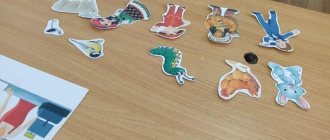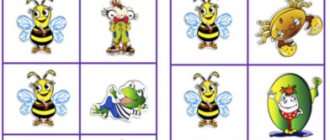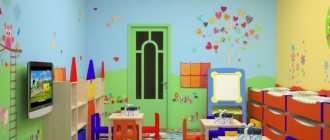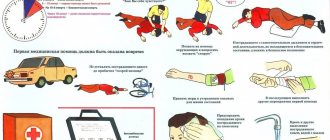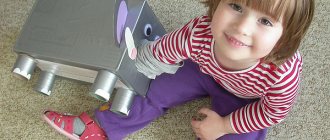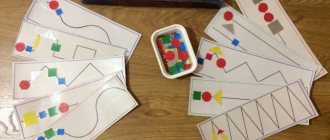What teaching aids can you make yourself for kindergarten?
Language development is not an isolated skill. To a large extent, it is determined by the general level of development of the child and, in particular, his intelligence.
Didactic manual on speech development
Activities that improve sensory and fine motor skills in children are of great importance in this process. For this, it is important to use teaching aids, a significant part of which can be made independently.
Children's learning, especially in junior and middle groups, should take place in a playful environment, otherwise they will lose interest in the subject and time will be wasted. For teaching to be effective, the teacher needs to use all available means to maintain the child’s useful activity.
Didactic materials for sensory development
The “Flower Petals” manual looks like this. A circle is attached perpendicularly to the straight stem. The edges of the central part are covered with Velcro. Several petals with images of objects or fairy-tale characters are offered. This fabric is also attached to the inner edge of each of them. The task is to find the petals with the corresponding words based on the letter drawn on the mug and attach them to the central part.
The game “Blow out the insects into the clearing” is designed to develop speech breathing. For this purpose, the “Polyanka” manual is used. It is a low box with high sides. Small cardboards with images of animals are suspended on short threads from the outside. The child must blow them out, but does not have the right to puff out his cheeks.
Important! In this way he is taught how to breathe correctly during a conversation.
The game "Clothespins" is made using the same manual. For this, the kids are given several colored clothespins and asked to build a fence. They place them on the edges, while loudly calling out the color used.
There are two horizontal lines of Velcro glued to the outer wall of the Polyanka manual. Each row contains four cards with images of animals, fairy-tale characters or objects. The child is told that in each row one of the pictures is extra and is asked to remove it. Then he should tell what the remaining images have in common and why.
Lesson with children
Iconic didactic materials
One of these multifunctional aids is “Teremok”. It is a fabric house attached to a flat, solid base. It has a large number of pockets sewn into it, in which various pictures are placed. They can depict objects of the surrounding world, fairy-tale characters from the fairy tale of the same name, images of letters or syllables.
How to help your child learn to speak correctly and well
There are various ways to use this manual in kindergarten.
Here's one of them. Children are shown pictures taken from a pocket attached to the tower. They ask what fairy tale this hero, who is depicted on the card, came from. The child must remember the name of the fairy tale and try to retell its content.
Important! If the child needs the help of a speech therapist, then it is provided. During the story, the teacher asks the child simple leading questions.
You can also use this manual in a preschool educational institution as follows:
- The teacher takes out cards showing the inhabitants of the tower, but does not show them. He depicts the sounds these animals make. The child must repeat them and name the hero of the fairy tale who is depicted on the card.
- The manual can be used to study prepositions that show the relative position of cards. The teacher places cards with pictures of animals in various pockets and asks questions about who is located where. The child must answer using the prepositions “above,” “under,” or “between.”
- Then the child is asked to formulate questions using the mentioned prepositions and ask them to the teacher.
Another task is the following:
- The child is given cards with images of fairy tale characters and asked to place them in various pockets.
- After this, the kid must say which animal lives on which floor and who is to the left, right, above or below him.
Types and examples of didactic games for preschoolers
Didactic games differ in content, actions, rules and come in three types:
- games with objects;
- printed board games;
- verbal didactic games.
Their degree of difficulty can be adjusted depending on the age of the participants. The same game can have several variants. For example, kids arrange cards by color; Older children name numbers; and someone can already put the word together.
Games with objects
1. Magic bag
You need to pull out objects of different shapes by touch from the bag: a ball, a cube, a pyramid. Or objects with different textures: pine cone, acorn, chestnut.
2. Rainbow
The child is invited to arrange cubes, mosaics, and pyramids by color.
During didactic games with objects, the child learns to think, analyze, compare objects with each other, he becomes more attentive, his horizons expand, and his fine motor skills improve.
Board-printed games
There is a huge scope for choosing what will be most interesting to your baby at a given time. It can be:
- Pictures for recognition in the form of images, shadows, contours.
- Puzzles.
- Lotto.
- Pictures: find the differences.
- Pictures: pick a pair.
- Labyrinths.
- Designers.
Such didactic games for preschoolers on speech development are interesting and educational. They successfully develop speech skills, logic and imagination, and develop perseverance and patience.
Word games
This type of cognitive communication is very relevant when there are no special objects at hand, so you can use the most familiar things. Here are some examples of such didactic games for the development of speech in preschoolers.
1. Doll
Description of the appearance: color of hair, eyes, clothing items of the fashionable doll.
2. Who is missing?
Place several soft toys nearby. Ask them to close their eyes and remove one. Who can guess: who is missing? We need to name it, tell it what it looks like, figure out where it ran away to.
3. Cube
They roll a dice with pictures on each side. You need to name what is depicted on the top edge and imitate the sound of the object. For example, a steam locomotive. How does the locomotive sound?
4. Catch the ball - name the word that has the opposite meaning. Hot-cold, big-small, close-far.
Verbal games for preschoolers develop speech, reaction speed, correct pronunciation of sounds, expand vocabulary, teach how to construct sentences correctly, and express their thoughts coherently.
Where are teaching materials used?
The use of hand-made speech development aids for preschoolers creates a playful basis for working with them and determines the storyline of the lesson. A child, especially in the junior and middle groups of kindergarten, thinks concretely, using images, rather than abstract logical constructs. He can react to assignments received from a speech therapist or teacher, being a participant in a specific, albeit fictitious, situation. The teaching aids serve as the factual basis for their learning each year.
Speech development based on visual cues
When a child learns to express his thoughts, he must follow a certain pattern of expressing his thoughts. For a child who is almost unable to concentrate on one subject at his age, this is impossible. Using teaching aids in the form of cue cards helps build a story line. For younger children, we are talking about much simpler things. They simply have to name the objects or briefly describe the actions with the cue cards.
Speech therapist works with a child
For example, in the didactic manual “Zippers,” the child must choose among the open colored zippers lying on the table those that correspond to the teacher’s instructions and close them. At the same time, the child describes his choice, its reasons and the actions he takes.
At an older age, each visual cue can be used together with leading questions from the teacher and be the basis for a coherent story. This can be seen, for example, in classes devoted to professions.
Mnemonic diagrams for speech development for senior and preparatory groups
Every description of your actions, answer to a specific question, or short story based on visual cues helps your child better develop his speech skills. Serve as preparatory exercises for adult life.
Learning to retell
The development of coherent speech in children is one of the most important skills that a child must be taught. Without mastering it, he will not only not be able to develop properly intellectually, but also will not be able to fully socialize, not being able to conduct a dialogue or express his thoughts.
When retelling, the child must create a coherent, long story. However, for this he will need tips, which can be received during didactic games and from the teacher.
The development of fine motor skills plays an important role in this process.
Important! By engaging in retelling, you will be able to strengthen your speech and intellectual skills and increase the level of development of your personality.
Learning to think
Human speech is closely related to thinking. The same is true for a child. Communication is not limited to expressing your thoughts or describing actions. The level of speech proficiency is largely determined by the degree of development of the child’s personality and thinking.
Do-it-yourself teaching aids for kindergarten can be used not only for stories, but also as an excuse to ask your child questions about cause-and-effect relationships in the world around him. For example, using cards related to the plots of fairy tales, you can ask questions about the circumstances of the characters’ actions, the reasons and consequences of their actions.
You can combine the classes in question with the study of mathematics.
In addition, the educational function of speech development classes is important. For example, if a child is asked questions about the features and beneficial properties of the plants depicted in the pictures, then gradually this knowledge will be consolidated in the child. If additional questions are asked about this material, the child’s knowledge will become more detailed and practical.
Preparing for literacy
To do this, you need to learn not only oral speech, but also study letters and words. Children of senior preschool age, with the help of a teacher and parents, are able to master the alphabet and basic reading skills.
For this purpose, a do-it-yourself didactic manual on speech development for kindergarten with cards depicting letters, syllables or words can be used.
Picture 4 Speech corner
DIY didactic games for speech development
Yana Glebova
DIY didactic games for speech development
Educator: Glebova Ya. V
Preschool age is a period of active acquisition by a child of spoken language, the formation and development of all aspects of speech: phonetic, lexical, grammatical. The sooner learning the native language begins, the more freely the child will use it in the future.
Everyone knows that games have a general developmental effect on speech. The methodology includes various didactic games in which the tasks of activating and clarifying one or another grammatical form are solved, for example, helping children master the genitive plural, the imperative mood of the verb, the agreement of words in gender, ways of forming words (the names of baby animals, people of different professions, cognates). Games aimed at teaching children storytelling develop their ability to describe an object based on its main features (color, shape, size, actions; talk about an animal, a toy; compose a plot from a picture, develop it in accordance with the plan. The didactic task is clothed in gaming situations in which incentives for a coherent presentation of thoughts clearly appear. Thus, games and exercises solve in a complex all the tasks of speech development (education of sound culture of speech, formation of the grammatical structure of speech, vocabulary work, development of coherent speech).
Didactic games that have a complex impact on vocabulary, grammar, and coherence of speech should be interesting and exciting. I decided to make my own didactic manual for children of senior preschool age on speech development.
Didactic manual “Speech Transformer”
Target:
enrichment of active vocabulary, development of coherent, grammatically correct dialogical and monologue speech.
Description of the manual:
the desktop didactic manual is the author's development, intended for children of senior preschool age; consists of a base-stand and three replaceable blocks, each block contains a didactic game. The manual can be used in individual work with children, as well as in joint and independent activities.
1-BLOCK: Didactic game “Write your own fairy tale”
Target:
improve the ability to compose short fairy tales on a given topic “Once upon a time in the forest.”
Game description:
The child selects a block with a forest image, places it on a stand and secures it with an elastic band. The game comes with an envelope containing pictures depicting various fairy tale and cartoon characters. He is invited to compose his own fairy tale on the theme “Once upon a time in the forest”, and place several heroes on the panel; characters can be changed depending on the development of the plot. When choosing appropriate characters to tell, children give their descriptions and characteristics.
2-BLOCK: Didactic game: “Look and tell the story”
Target:
improve the ability to compose stories based on a set of pictures with sequentially developing action.
Game description:
the child selects a block with plot pictures, places it on the base of the stand and secures it with an elastic band. The paper film movement regulators are fixed at the top and bottom of the block; red arrows indicate the direction of movement. The child watches five stories with sequentially developing action and composes stories to choose from. Storytelling through a series of plot pictures develops in children the ability to develop a plot line, come up with a title for the story in accordance with the content, and connect individual sentences and parts of statements into a narrative text.
3-BLOCK: Didactic game “Magic Locker”
Target:
improve the ability to form nouns using the suffix protsa with the meaning of container
Game description:
The child selects a block with a picture of a store, places it on a stand base and secures it with an elastic band. The game comes with subject pictures: different products, a grocery cart, a boy, a girl.
Invite your child to “go to the grocery store.” Place pictures of products in a cart, name the products using sentences, for example: “I bought bread, I bought candy, etc., take the cart home. At home, put the purchased products in the “Magic Cabinet”, in which a piece of prostrate lives, and guess the name of the dish in which the products need to be placed. The child puts food in a cabinet and names, for example: the noun sugar - with the help of the suffix protsa forms a new word sugar bowl, etc. (sugar bowl, bread bowl, candy bowl, salad bowl, napkin bowl, pepper shaker).
The importance of didactic material in kindergarten
Didactic manuals serve as the basis for speech development classes. They create a storyline for the lesson, involving children in the game plot. This takes into account the concreteness and figurativeness of children's thinking. With their help, a fascinating game situation is created for the child to learn, where he is passionate and motivated to complete tasks.
The development of children's speech relies heavily on various didactic aids. Their diversity and the ability to make most of them with your own hands allows you to choose a suitable option for conducting classes with children.
